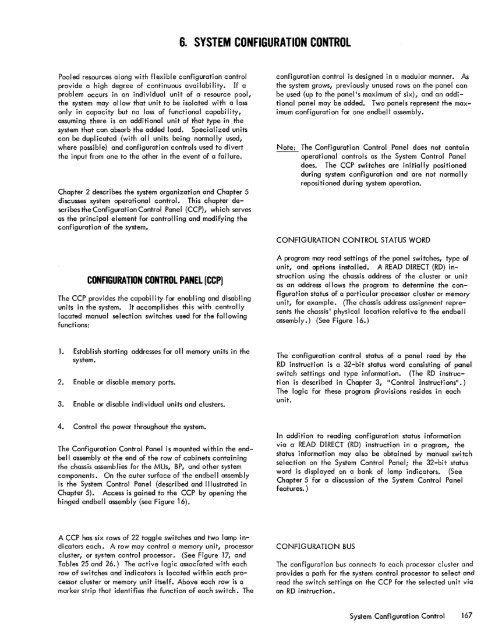1. xerox 560 computer system - The UK Mirror Service
1. xerox 560 computer system - The UK Mirror Service
1. xerox 560 computer system - The UK Mirror Service
You also want an ePaper? Increase the reach of your titles
YUMPU automatically turns print PDFs into web optimized ePapers that Google loves.
6. SYSTEM CONFIGURATION CONTROLPooled resources along with flexible configuration controlprovide a high degree of continuous availability. If aproblem occurs in an individual unit of a resource pool,the <strong>system</strong> may allow that unit to be isolated with a lossonly in capacity but no loss of functional capability,assuming there is an additional unit of that type in the<strong>system</strong> that can absorb the added load. Specialized unitscan be duplicated (with all units being normally used,where possible) and configuration controls used to divertthe input from one to the other in the event of a failure.Chapter 2 describes the <strong>system</strong> organization and Chapter 5discusses <strong>system</strong> operational control. This chapter describesthe Configuration Control Panel (CCP), which servesas the principal element for controlling and modifying theconfiguration of the <strong>system</strong>.CONFIGURATION CONTROL PANEL (CCP)<strong>The</strong> CCP provides the capability for enabling and disablingunits in the <strong>system</strong>. It accomplishes this with centrallylocated manual selection switches used for the followingfunctions:configuration control is designed in a modular manner. Asthe <strong>system</strong> grows, previously unused rows on the panel canbe used (up to the panel IS maximum of six), and an additionalpanel may be added. Two panels represent the maximumconfiguration for one endbell assembly.Note: <strong>The</strong> Configuration Control Panel does not contain--- operational controls as the System Control Paneldoes. <strong>The</strong> CCP switches are initially positionedduring <strong>system</strong> configuration and are not normallyreposi ti oned duri ng <strong>system</strong> operati on.CONFIGURATION CONTROL STATUS WORDA program may read settings of the panel switches, type ofunit, and options installed. A READ DIRECT (RD) instructionusing the chassis address of the cluster or unitas an address allows the program to determine the configurationstatus of a particular processor cluster or memoryunit, for example. (<strong>The</strong> chassis address assignment representsthe chassis ' physical location relative to the endbellassembly.) (See Figure 16.)<strong>1.</strong> Establish starting addresses for all memory units in the<strong>system</strong>.2. Enable or disable memory ports.3. Enable or disable individual units and clusters.<strong>The</strong> configuration control status of a panel read by theRD instruction is a 32-bit status word consisting of panelswitch settings and type information. (<strong>The</strong> RD instruction is descri bed in Chapter 3, .. Control Instructi ons" • )<strong>The</strong> logic for these program provisions resides in eachunit.4. Control the power throughout the <strong>system</strong>.<strong>The</strong> Configuration Control Panel is mounted within the endbellassembly at the end of the row of cabinets containingthe chassis assemblies for the MUs, BP, and other <strong>system</strong>components. On the outer surface of the endbell assemblyis the System Control Panel (described and illustrated inChapter 5). Access is gained to the CCP by opening thehinged endbell assembly (see Figure 16).In addition to reading configuration status informationvia a READ DIRECT (RD) instruction in a program, thestatus information may also be obtained by manual switchselection on the System Control Panel; the 32-bit statusword is displayed on a bank of lamp indicators. (SeeChapter 5 for a discussion of the System Control Panelfeatures. )A CCP has six rows of 22 toggle switches and two lamp indicatorseach. A row may control a memory unit, processorcluster, or <strong>system</strong> control processor. (See Figure 17, andTables 25 and 26.) <strong>The</strong> active logic assocIated with eachrow of switches and indicators is located within each processorcluster or memory unit itself. Above each row is amarker strip that identifies the function of each switch. <strong>The</strong>CONFIGURATION BUS<strong>The</strong> configuration bus connects to each processor cl uster andprovides a path for the <strong>system</strong> control processor to select andread the switch settings on the CCP for the selected unit viaan RD instruction.System Configuration Control 167
















